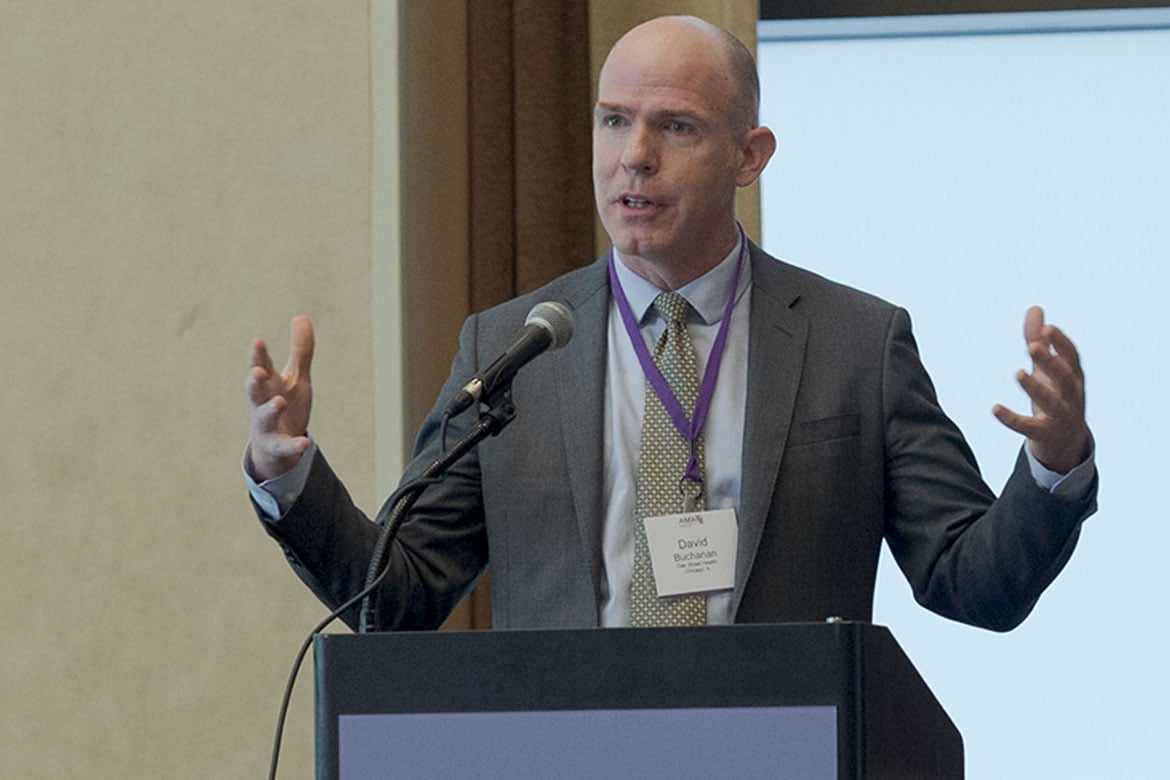The business model for Oak Street Health, a private equity-backed, for-profit health care operation, involves full-risk contracting to provide care for Medicare patients with complex conditions.
Its clinical model, meanwhile, involves a primary care focus featuring longer, more frequent visits supported by integrated care teams and sophisticated IT tools that are used to develop and carry out individualized care plans.
“There is tremendous alignment between patients doing well and Oak Street doing well as a company,” said David Buchanan, MD, Oak Street’s chief clinical officer, during a recent education session for physicians.
The organization started in Chicago six years ago and now has nearly 50 clinics in five states, with each clinic having capacity for 3,500 patients. Dr. Buchanan (pictured above) said he expects those numbers to grow to grow significantly by the end of 2020.
Oak Street care teams hold daily huddles to plan for patients coming in that day. Also, patients are tiered according to health status and there are weekly structured reviews assessing the needs of the highest-risk patients. Those highest-risk patients are also seen every 2-3 weeks on average in the center to keep on top of their health issues.
All Oak Street patients have complex care needs and all are Medicare patients. Other significant characteristics of the Oak Street patient panel include:
- 42% are also dual-eligible for Medicaid and their average income is less than $21,000.
- 52% are between 65 and 74 years old.
- They have an average of four chronic conditions such as hypertension, diabetes, congestive heart failure or chronic obstructive pulmonary disease.
- They take an average of 7.2 medications.
- They have complex behavioral and social needs, with 35% diagnosed with depression and 20% with a substance-use disorder.
The company is not publicly traded and keeps its financial performance private. But Dr. Buchanan did share with his physician audience some highlights of the organization’s clinical performance.
So far, Oak Street Health has achieved a:
- 50% reduction in hospital admissions.
- 52% reduction in emergency department visits.
- 35% reduction in 30-day readmission rate.
- 90% retention rate with its patients.
Dr. Buchanan credited the organization’s hospitalization-reduction to stepping up the “dosage of primary care” that patients receive.
“I’m a primary care doctor, so that’s the view of the world I take,” he said during the education session, which was hosted by the AMA Integrated Physician Practice Section during the 2019 AMA Annual Meeting in Chicago.
New question, new focus
Dr. Buchanan also talked about the difference between operating in a fee-for-service environment and Oak Street’s fully capitated risk model. An organization he previously worked for was paid around $125 for an office visit and he had to figure out how to deliver the highest quality of care for that amount and still pay all the bills. Now his task is based on avoiding a hospital visit costing around $17,000.
“How can we spend an amount less than $17,000 to keep my patient healthy and out of the hospital?” Dr. Buchanan said. “It’s very exciting to have the opportunity to answer this different question.”
Helping Oak Street’s physicians find solutions: a team of scribes, social workers, and behavioral health specialists, 200 community outreach workers and a fleet of around 100 vans that provide patients with free transportation to the company’s clinics.
He noted that each clinic has a community room that serves as a neighborhood asset and gathering place for Bingo games and other social and physical activities.
“Sometimes I think one of our clinical interventions is Bingo, because patients much prefer to come in for Bingo than to see me,” Dr. Buchanan said with a laugh, adding that patients receive preventive care such as flu shots when they attend activities. “They certainly wouldn’t come in just for a flu shot in the middle of winter in Chicago. But they’ll come for Bingo.”





